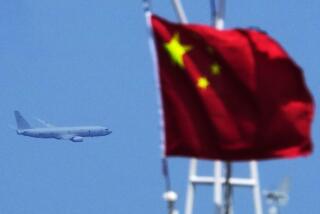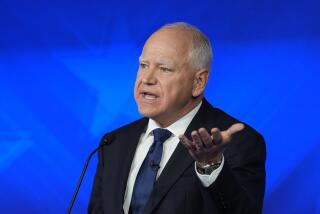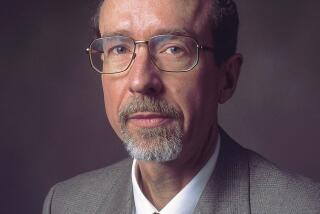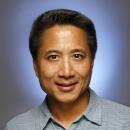China’s Eternal Parade Ground
- Share via
BEIJING — As public spaces go, it’s not a pretty sight: a vast plain of concrete bounded by a mishmash of architecture, including a mammoth Stalinist government building and a three-story Kentucky Fried Chicken outlet.
But as symbols go, Tiananmen Square is one of the most recognizable on Earth, 100 acres spread out under the heavy-lidded gaze of Mao Tse-tung and featured in countless cutaway shots by filmmakers needing a quick and easy emblem of China.
For many in the West, Tiananmen Square has become synonymous with a single event: the 1989 crackdown on pro-democracy protesters that killed hundreds, perhaps thousands, of people. So dominant is the square as a symbol of repression that critics are blasting President Clinton for agreeing to meet Chinese leaders there this week during the first visit by a U.S. president since the massacre.
But in China itself, that bloody event represents just one layer of meaning out of many covering the square--the world’s largest public plaza. Along with the ancient Gate of Heavenly Peace that overlooks it and gives the plaza its name, Tiananmen Square has been part of the political landscape here for centuries. Ming Dynasty emperors ruled over it as part of the southern approach to the Forbidden City, and Mao basked in the adoration of Red Guards who packed the square by the millions.
Since Mao established the People’s Republic in 1949, the square has hosted scores of foreign dignitaries, including former U.S. presidents Richard Nixon and George Bush. For Clinton to avoid Tiananmen during this week’s summit would constitute an insult to national dignity in the eyes of some Chinese and a departure from standard procedure for the government.
“This has been the protocol of China for many years,” Foreign Minister Tang Jiaxuan said Tuesday. “Not to hold a welcoming ceremony at [Tiananmen Square] in honor of President Clinton, such an important guest of state, would be abnormal and discourteous.”
To many Chinese citizens, Tiananmen Square is this country’s paramount symbol of state, enshrined in the official national emblem and pictured on every note of currency. The square has been witness to several defining moments in China’s tumultuous history, including--but not limited to--the demonstrations nine years ago.
“Tiananmen Square is definitely the central symbol of China,” said Yan Yufen, 46, a factory worker in the city of Taiyuan, about 250 miles southwest of Beijing. “The last time I was there watching the national flag being raised, I was so excited that I couldn’t help bursting into tears.”
Author David Bonavia, a former China correspondent for the Times of London, once wrote of Tiananmen Square: “The patriotic emotions stirred by that name are extraordinary. No city except Mecca or Moscow has a monument to match its magnetic hold on hundreds of millions of people.”
Clinton will be officially received Saturday at the Great Hall of the People, the massive legislative and banqueting structure whose Stalinist bulk stretches along the square’s western edge for a full quarter of a mile. (Nixon and Bush ate there.) Clinton’s meetings with President Jiang Zemin will take place in the central government compound of Zhongnanhai, just a stone’s throw away.
Birth During a Golden Age
But Tiananmen Square’s association with political power in China extends back more than a millennium, to long before either the Great Hall or Zhongnanhai ever appeared on a draftsman’s drawing board.
The first open space where the square now sprawls was cleared during the Tang Dynasty (AD 618-907), the golden age of ancient China. Although Beijing was not the capital then, the royal family kept a home here, and part of what is now Tiananmen Square served as a courtyard outside the home’s main entrance.
After Kublai Khan founded the Yuan Dynasty in the 13th century, China’s new Mongol emperors moved the capital to Beijing, where construction began in earnest, including on the first incarnation of Changan Avenue (Avenue of Eternal Peace), the broad east-west thoroughfare at the northern end of the square that until recently still bore the tread marks of tanks from the 1989 crackdown. During the Yuan Dynasty, the square began to assume its present shape, although that was but a fraction of the 160-football-field expanse it is now.
By the middle of the Ming Dynasty, more than a century later, the Tiananmen area had been built up--and had become closely identified with the seat of imperial power.
A 17th century map shows that the square, paved with stone slabs, was walled off as part of the Forbidden City, accessible only to the emperor and his court.
Imperial guards marched off to battle through the Gate of Heavenly Peace, whose antecedent, the Gate of Heavenly Succession, was erected in 1417 by the Ming emperor Zhu Di. Royal edicts were written on scrolls, wedged in the beak of a phoenix-shaped gilded box and lowered from the top of the gate to kneeling officials below, who then promulgated the laws throughout the Middle Kingdom.
From that spot atop the gate centuries later, Mao Tse-tung announced the founding of the Communist People’s Republic to the cheers of thousands massed in Tiananmen Square. “The Chinese people have stood up,” he proclaimed.
For most modern Chinese, Tiananmen Square’s strongest associations are with key events in 20th century Chinese history.
“Perhaps no other place in China better symbolizes the turbulent course of modern Chinese history, both for better and for worse, than does this one spot,” Harry Harding, a China expert at George Washington University, said recently.
In fact, one of the events lending Tiananmen Square its significance was a series of student protests that began there 70 years before the demonstrations of 1989.
Famous Student Protest--of 1919
On May 4, 1919, about 3,000 young scholars from 13 colleges and universities rallied in the square to protest the loss of Shandong province to Japan at the Paris Peace Conference after World War I. The students drew sympathetic crowds, some of them weeping, with their impassioned defense of Chinese territorial integrity and their denunciation of the government for its quiescence. “Protect our sovereignty!” they declared. “Oppose power politics! Down with traitors!”
Foreshadowing what would happen seven decades later, the students’ march through Beijing from the Tiananmen plaza ended in violence that night. Demonstrators were beaten and arrested; one person died.
But the “May 4th Movement,” which spawned further patriotic--and sometimes bloody--protests in Tiananmen Square throughout the 1920s, became a beacon and is still celebrated today as an early turning of the tide against imperialism. In 1989, the students who flocked to the square calling for greater democracy and freedom considered themselves the inheritors of the tradition of May 4, 1919.
“The square had been used by the people to criticize a corrupt and insufficiently nationalistic government even before the founding of the [Chinese Communist] Party” in 1921, said Stanley Rosen, a Sinologist at USC. “This is one important reason why the [1989] students feel that their revolutionary credentials predate the Communist Party’s credentials.”
But the Communist regime co-opted the May 4th Movement for its own ends as well, commemorating it as part of the Communist revolution and depicting the struggle on the base of the 120-foot Monument to the People’s Heroes in the middle of Tiananmen Square. The government unveiled the monument in 1958, about the time that workers quadrupled the square to its present size, tearing down the surrounding alleyways, homes and trees.
The expansion allowed millions of Mao’s fanatical Red Guards to parade through the square during the 1966-76 Great Proletarian Cultural Revolution, waving their little red books, chanting slogans and sobbing at the sight of the Great Helmsman, in some of the most enduring images to come out of China during that period. (Mao’s embalmed body now lies in a large mausoleum at the southern end of the square.)
But the square’s expansion also created the space for hundreds of thousands of citizens who converged on it in April 1976, ostensibly to mourn the death of Premier Chou En-lai but implicitly to criticize the radical policies of the previous decade, in which thousands of Chinese were persecuted and killed.
Ten years later, in the winter of 1986-87, students once again staged a massive rally in Tiananmen Square, selecting the potent symbolic site to demand democratic reforms, which the government rejected.
Then came the 1989 demonstrations, which captured the world’s imagination unlike any event the square had seen.
Over six heady weeks, what began as a youthful stand against authoritarianism swelled into an outpouring of support from hundreds of thousands of Beijingers, whose marches on Tiananmen Square both protested and reaffirmed the square’s historic role as the embodiment of state power.
When tanks rolled in June 4 and gunned down civilians, television viewers worldwide were stunned.
Some witnesses say no one was killed in the square itself, only in the streets leading to Tiananmen. But such hair-splitting makes no difference to human rights advocates, including prominent Chinese dissidents, who accuse Clinton of dishonoring the memory of those who died by acceding to the greeting on the square.
“If the Clinton administration accepts a welcome from the murderers at that location, then that itself takes on greater political significance,” exiled democracy activist Wei Jingsheng said in the U.S. last week. “The acceptance of this welcoming ceremony represents that there has been a dramatic retreat on the question of human rights by the Western governments.”
Police Keep Close Watch on Square
The legacy of the 1989 assault lingers like a sour taste. Plainclothes police officers continue to patrol Tiananmen for “suspicious” activity, hustling away locals handing out leaflets or reporters trying to conduct interviews. Some say you can still find a bullet hole gouged into the Monument to the People’s Heroes, left over from the firing by army troops.
But the daily bustle in the plaza--which attracts hordes of tourists and residents flying their kites, riding their bikes and having their pictures snapped at one of 15 photo kiosks--has returned to normal.
For many Chinese, the massacre has simply been added to the long catalog of defining events that have occurred in a place once called “the spiritual hub of all China.” Last year, hundreds of thousands streamed into the square in June--not to commemorate the 1989 protests but to celebrate Hong Kong’s imminent return to Chinese rule.
In the opinion of Zhang Yong, 22, Clinton should definitely make a stop at the square, despite the bloodshed nine years ago.
“The two things should be separated,” he said. “Going to participate in the Tiananmen ceremony is something every state leader does. . . . As the leader of one of the world’s great nations, it is a great honor for him to go there.”
Jason Dean in The Times’ Beijing Bureau contributed to this story.
* ON THE BEATEN PATH: President Clinton’s China trip will begin in a town well-versed in the tourist trade. A10
(BEGIN TEXT OF INFOBOX / INFOGRAPHIC)
Tiananmen Square: Evolution of a World Landmark
A look at the evolution of the square and the ancient Gate of Heavenly Peace that overlooks it and gives Tiananmen Square its name:
Tang Dynasty (AD 618-907): First open space is cleared on the eventual site of Tiananmen Square for a courtyard leading to the imperial family’s home.
13th Century: Mongol rulers move capital to Beijing and start building up square.
1417: The Ming emperor Zhu Di constructs the first Gate of Heavenly Peace from which Ming rulers would promulgate new laws. The square is walled off, and only the emperor and his entourage are allowed access until the early 20th century.
1651: The gate is rebuilt and renamed Tiananmen (Gate of Heavenly Peace).
1919: Students protesting loss of territory to Japan after World War I gather on May 4, prompting the famous “May 4th Movement” and sparking scattered nationalist demonstrations at the square throughout the next decade.
1949: Mao Tse-tung announ-ces the People’s Republic of China to thousands of cheering supporters.
1958: The square quadruples in size to its present dimensions, with the massive Great Hall of the People on the west side.
1966-76: Millions of Red Guards troop through the square to glimpse Chairman Mao during the Cultural Revolution.
1972: President Nixon dines with Mao in the Great Hall of the People.
1976: Hundreds of thousands pack Tiananmen to honor the memory of Premier Chou En-lai and implicitly criticize the Cultural Revolution.
1984: The Gate of Heavenly Peace is renovated; “paramount leader” Deng Xiaoping watches parades in the square below marking the 35th anniversary of the People’s Republic.
1986-87: Students stage massive protests to demand democratic reforms.
1989: On June 4, the government orders tanks to roll into Tiananmen Square, killing hundreds, possibly thousands, of protesters.
1997: Celebrations in the square on the night of June 30 mark Hong Kong’s return to Chinese control.
More to Read
Sign up for Essential California
The most important California stories and recommendations in your inbox every morning.
You may occasionally receive promotional content from the Los Angeles Times.














